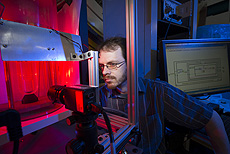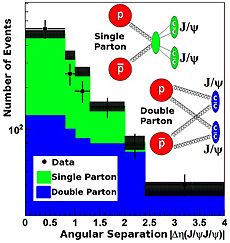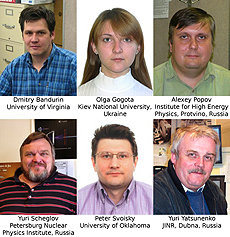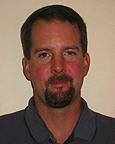|
Thursday, May 29
- Breakfast: Canadian bacon, egg and cheese Texas toast
- Breakfast: corned beef hash and eggs
- Carolina pulled-pork sandwich
- Smart cuisine: barbecue chicken breast
- Honey baked ham
- Buffalo chicken tender wrap
- Grilled- or crispy-chicken Caesar salad
- White chicken chili
- Chef's choice soup
- Assorted pizza by the slice
Wilson Hall Cafe menu |
|
Friday, May 30
Dinner
- Melon and prosciutto
- Medallions of beef with madeira mushroom sauce
- Potatoes gratin
- Asparagus
- Chocolate souffle
Wednesday, June 4
Lunch
Menu unavailable
Chez Leon menu
Call x3524 to make your reservation.
|
|
Eric Dahl receives DOE award to develop hybrid dark matter detector
 |
Eric Dahl is one of this year's DOE Early Career Research Award recipients.The award supports his search for dark matter using a new style of particle detector. Photo: Reidar Hahn
|
Eric Dahl, a joint Fermilab-Northwestern University physicist, recently received an award from the Department of Energy to develop a new style of particle detector for finding dark matter particles, the nearly invisible matter that makes up more than 80 percent of our universe.
Dahl is a recipient of the DOE Early Career Research Award, a prestigious honor given annually to outstanding scientists early in their careers. University researchers receive $150,000 a year for five years to cover summer salary and research expenses.
Dahl has worked extensively on two styles of dark matter detector experiments. Graduating from Princeton University in 2009, he worked on the development of xenon time projection chambers, and he currently works on the PICO bubble chamber experiment, a ton-scale successor to COUPP, which is scheduled to begin taking data in 2017. His new prototype will use elements from both detector types.
"By combining the two technologies, you get the best aspects of both without really losing anything," Dahl said.
Bubble chambers, such as the SNOLAB-based PICO, contain a superheated fluid that on its own will not boil. When a particle interaction deposits a critical amount of energy in the fluid, however, a vapor bubble is created.
This technology excels at separating the dark matter signal from the most common backgrounds, including gamma and beta decays, but researchers using this type of detector face challenges weeding out alpha decays. They also can't tell how much energy was deposited in the interaction responsible for a given bubble.
In a xenon time projection chamber, such as the South Dakota-based LUX, particle interactions within the liquid xenon produce two signals: a flash of scintillation light and a delayed ionization signal. The background discrimination is weaker than in the bubble chamber, but the scintillation signal gives the energy of the interaction, which also eliminates alpha decays as a background.
Dahl's prototype would use liquid xenon as the target of a standard PICO bubble chamber, with additional instrumentation to detect xenon scintillation light. The chamber should have the gamma and beta discrimination of a bubble chamber plus the energy information and alpha discrimination of a xenon TPC. Lower backgrounds mean greater sensitivity to dark matter.
"The more that I thought about it, the more that I thought it would work really well," Dahl said. "I found myself getting excited about doing the work as I was writing the proposal."
Read more
—Rhianna Wisniewski
|
Phlox to enjoy on site
 |
| Woodland phlox blooms east of the large prairie along Kirk Road. Photo: Gordon Garcia, Bartlett, Illinois
|
|
June wellness offerings and fitness classes
Fermilab pool opens Tuesday, June 10. Register for adult water fitness and children's swim lessons now. Register for any of the fitness classes beginning in June: Martial Arts, Strength Training, Butts and Guts, and Yoga. Information about summer Zumba classes is coming soon.
Pool opens
June 10
Tuesday-Friday, open noon-7 p.m.
Saturday-Sunday, open 1-6 p.m.
Mondays - closed
Individual membership: $126
Family membership (up to 4): $294
Extra family members: $54
Daily rate: $8/person; after 4 p.m.: $6/person
Fermilab pool Web page
Register for adult water fitness and children's swim lessons at Jeff Ellis Management.
Registration is due one week prior to start of class.
Fitness Classes
Martial Arts
Mondays and Wednesdays, June 23-July 30, 5-6 p.m.
Fitness Center Gym
$60/person. Register by June 16.
Strength Training by Bod Squad
Tuesdays and Thursdays, June 24-Aug. 28 (no classes July 15-24), 5-6 p.m.
Fitness Center Exercise Room
$82/person. Register by June 17.
Butts and Guts
Fridays, June 27-Aug. 22 (no class July 4), 11:45 a.m.-12:30 p.m.
Fitness Center Exercise Room
$60/person. Register by June 20.
Yoga
Mondays, June 30-Aug. 4, noon-12:45 p.m.
WH ground-floor east Training Room
$45/person. Register by June 23.
Thursdays, June 26-July 31, noon-12:45 p.m.
WH ground-floor east Training Room
$45/person. Register by June 19.
Athletic League
Outdoor soccer
Tuesdays and Thursdays, 6 p.m.
Village soccer field
Contact O'Sheg Oshinowo for more information.
Employee discounts can be found at the discounts Web page.
For more information or to register for classes, visit the Wellness Web page.
|
New plan for U.S. particle physics: go international
From Science, May 22, 2014
It's a gamble that leading U.S. particle physicists say they must take: To finally get started on building their next megaproject at the United States' sole particle physics lab — Fermi National Accelerator Laboratory (Fermilab) in Batavia, Illinois — they want to stage it as an international collaboration — even if that means ceding direct control of the experiment to a council of member nations.
That recommendation comes from a draft road map for U.S. particle physics presented today to a federal advisory panel in Washington, D.C. Requested by the Department of Energy (DOE) and the National Science Foundation (NSF) 8 months ago, the report of the ad hoc Particle Physics Project Prioritization Panel (P5) largely embraces the same main projects that physicists have been mulling for years. But it strikes a decidedly more international tone than previous plans. "Pursue the most important opportunities wherever they are, and host unique, world-class facilities that engage the global scientific community," reads the first of its 29 recommendations.
Read more
|
|
Double parton interactions – four times the charm!
 |
| A new publication by the DZero collaboration measures the production of pairs of J/ψ mesons. There are two possible mechanisms for this process, depending on the number of parton interactions in the proton-antiproton collision. The contributions from single- and double-parton interactions are separated by examining the angular separation of the two mesons, which is quite different for the two cases.
|
Disponible en español
Most of the time, a proton-antiproton "collision" is actually the interaction of one parton (quark or gluon) from the proton and one from the antiproton. The rest of the (anti)proton remnants generally continue their paths, undetected, down the beam pipe. Every so often, however, a second parton-parton interaction can occur in the same collision. The fraction of these "double-parton" (DP) interactions is an interesting quantity because it provides unique information about the distribution of the partons inside the proton: Are they spread out uniformly throughout the proton, or are they more clustered together?
The DZero experiment this week releases a new measurement of the prevalence of both single-parton and double-parton interactions by investigating the production of J/ψ ("jay psi") mesons, either singly or in pairs. These mesons themselves consist of a charm quark-antiquark pair. At the Tevatron, J/ψ mesons were usually produced from gluons, which split into the charm quark-antiquark pair, and so this measurement is especially sensitive to the distribution and properties of gluons within the colliding (anti)protons.
As well as gluon splitting, there is a second significant source of J/ψ mesons that must be accounted for in the analysis: the decay of hadrons containing a beauty quark. Such decays must be identified and subtracted from the total sample since they are not sensitive to the same underlying process. Fortunately, these beauty hadrons tend to travel some small but measurable distance in the detector, whereas direct J/ψ production happens at the initial collision. This allows the two components to be differentiated and the fractions of each computed with good precision.
For the single J/ψ events, scientists measured the production cross section and found it to be in excellent agreement with the Standard Model predictions. For the J/ψ pair events, there are two possible mechanisms: a single-parton interaction producing both mesons or a double-parton interaction, with each producing a single J/ψ meson. Again, the two possible sources are differentiated by examining the properties of the events, here the angular separation of the two J/ψ mesons. For the single-parton case, the mesons tend to be produced close together, while for DP interactions they are more uniformly distributed in space (see the figure above).
Using this technique, scientists measured the cross sections for both single- and double-parton interactions. The data indicate that both types of J/ψ pair production occur more often than theory would predict, with the DP cross section in particular being three times higher than predictions. This indicates exactly how important it is to produce such measurements, providing new constraints to improve the theoretical modeling.
Finally, taking the ratio of DP to single J/ψ production, we obtain the quantity σeff, which is a measure of the average distance between colliding partons in the (anti)proton. The measured value is 5.0 millibarns (or 5×10-27 square centimeters!), somewhat smaller than similar measurements sensitive to quark (rather than gluon) distributions. This is suggestive of gluons being more closely clustered within the proton than are quarks. The fact that we begin to be sensitive to such differences is a remarkable feat, testimony to the many years of dedicated study of the unique Tevatron data set.
—Mark Williams
 |
| These DZero members all made significant contributions to this publication. |
 |
| Erich Varnes, from the University of Arizona, was recently re-elected as the co-chair of the DZero Institutional Board for the next three years. The Institutional Board has an important governance role in the collaboration, working with the spokespersons to ensure that all aspects of the experiment are coordinated in an efficient and productive manner. We congratulate Erich, thank him for all his contributions to the experiment and wish him the best of luck in his continued position. |
|
US particle physics panel presents plan for the future
From Physics World, May 23, 2014
High-energy particle physicists in the US must build further international collaborations and co-operation, according to recommendations made by the Particle Physics Project Prioritization Panel's (P5) 2014 report, which was released yesterday. Top priorities over the next two decades include the US playing a vital role in upgrades to the Large Hadron Collider (LHC) at CERN in Switzerland and building a long-baseline neutrino facility based at Fermilab near Chicago. The report also calls for US participation in the planned International Linear Collider (ILC), should the project commence.
Read more
|
|